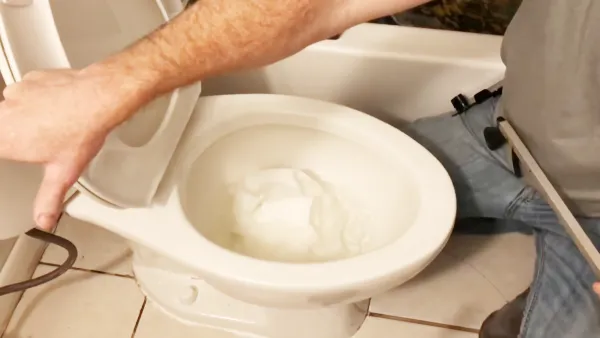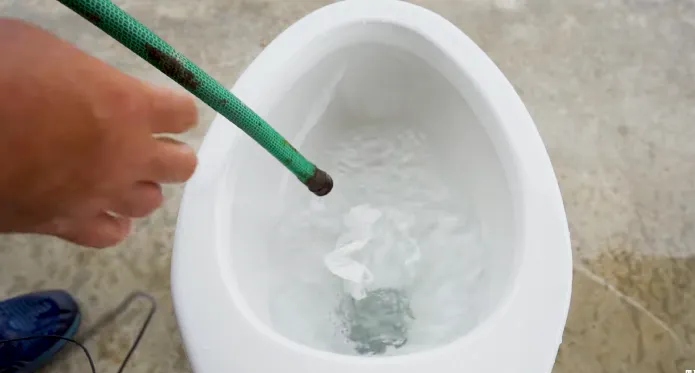Last Updated on October 17, 2023
Whenever you clean yourself with toilet paper after using the bathroom, you may wonder whether it is okay to flush it down the drain.
It is generally safe to flush toilet paper down the toilet in many parts of the world. Modern toilet paper is designed to break down quickly in water, making it unlikely to cause any plumbing issues.
But, there are several factors to consider when deciding whether it is safe to flush toilet paper or not. Toilet paper type and plumbing infrastructure in your area are two key factors in determining whether flushing toilet paper is safe.
We will examine all factors in more detail in order to help you make an informed decision regarding the safe flushing of toilet paper.
Is It Ok to Flush Toilet Paper: What Makes It Safe?

When determining whether it’s safe to flush toilet paper, there are several key factors to consider.
- Local plumbing infrastructure
- Type of toilet paper
- Quantity used
To assist you in determining whether flushing toilet paper is safe, let’s examine each factor in greater detail.
Local Plumbing Infrastructure
The local plumbing infrastructure may determine whether it is safe to flush toilet paper. In some areas, the plumbing systems are designed to handle the disintegration of toilet paper efficiently.
These modern systems have larger pipes and more powerful flushing mechanisms. As a result, the mechanism can easily move the dissolved toilet paper through the sewer lines without causing any clogs or backups.
But, in older or less developed regions, the plumbing may not be equipped to handle this type of waste effectively. If toilet paper is flushed regularly, the pipes might be smaller and prone to blockages, leading to potential plumbing issues.
Type of Toilet Paper
The form of toilet paper you use can also affect whether it is safe to flush. Modern toilet paper is made to disintegrate quickly and easily when exposed to water, reducing the risk of blockages in your plumbing system.
This is achieved through a combination of factors, including using shorter fibers and special manufacturing processes that break down the paper more effectively.
However, you should note that not all toilet papers are created equal. Some older or lower-quality brands may not break down as efficiently, which can increase the likelihood of clogs occurring.
To avoid this issue, look for toilet papers that are specifically labeled as ‘septic-safe’ or ‘flushable,’ as they have been tested and proven to be less likely to cause problems in your pipes.
Quantity Used
Using excessive amounts of toilet paper in a single flush can increase the risk of clogs. While using large amounts for extra comfort or hygiene may be tempting, doing so can negatively affect your plumbing system.
Flushing too much toilet paper at once overwhelms the pipes, causing blockages that are both inconvenient and costly to fix.
To prevent clogs, using a reasonable amount of toilet paper per flush is recommended. This ensures the proper functioning of the plumbing system and reduces the risk of potential damage or backups in your bathroom.
What Happens to Toilet Paper After It Is Flushed?
When you flush toilet paper, it undergoes a series of processes. The following are among them:
Flushing Action
When you press the lever of your toilet handle, the flushing mechanism starts. As the water from the tank rushes into the bowl, it carries away the waste and toilet paper as it passes through.
The rush of water creates a suction force that helps clear the toilet bowl. Afterwards, the flapper covers the drain hole, refilling the tank.
Toilet Paper Disintegration
As a result of the flushing action, the toilet paper disintegrates. The paper is engineered to weaken when it gets wet, and its fibers begin to separate. Fibers of smaller diameter are easier to pass through pipes without causing damage.
As the toilet paper comes into contact with water, it begins to weaken and break apart. The water helps to separate the fibers, leaving behind small particles that can flow through pipes with ease.
Transport Through Pipes
The force of the water from the flush propels this mixture forward, ensuring that it moves through the pipes in your home’s plumbing system.
Due to gravity and pressure, water, waste, and disintegrating toilet paper flow smoothly through the pipes.
As the mixture travels through the pipes, it encounters bends, turns, and different pipe sizes. However, these obstacles are designed to accommodate the flow and prevent any blockages or clogs.
Treatment in Sewer System
The waste and toilet paper eventually enter the municipal sewer system or septic tank.
In urban areas, wastewater is typically transported to a sewage treatment plant. This is where the magic happens, and your flush becomes a critical piece of the ecosystem.
Sewage Treatment Plant (If Applicable)
In sewage treatment plants, several processes remove impurities and contaminants from the mixture of water, waste, and toilet paper. This treatment process involves screening, settlement, biological treatment, and disinfection processes.
During these processes, the disintegrated toilet paper further breaks down into smaller components. This ensures that all contaminants are removed from the water before being released back into the environment.
Release Into the Environment
After undergoing treatment, the purified water is released back into the environment, usually into rivers or oceans. The remaining solid waste, including the byproducts of the toilet paper breakdown, is often processed into sludge.
This sludge may be used as fertilizer or disposed of in landfills. So, the simple act of flushing your toilet paper sets in motion a complex process that ultimately benefits our environment.
How can you tell if your plumbing can handle flushing toilet paper?

To assess whether you are able to flush toilet paper, drop a sheet of toilet paper into the toilet bowl and wait a few minutes.
If the toilet paper remains intact and doesn’t begin to disintegrate, it may indicate that your plumbing isn’t equipped to handle toilet paper disposal efficiently.
If it doesn’t dissolve adequately during this test, consider using less toilet paper per flush or exploring alternative disposal methods, such as a designated trash bin for used toilet paper.
What should you do if the toilet paper keeps clogging your toilet?
If you find that clogged toilet paper persists, there are a few steps you can take to address the issue.
Try using a flange plunger in the toilet bowl to push through the clogged material and excess waste. This can often resolve minor clogs caused by toilet paper overuse.
If the clog proves to be stubborn and persists, consider using a toilet auger. A toilet auger can effectively break up more challenging clogs by reaching further into the drain pipe.
Ensure Proper Toilet Paper Disposal for an Unclogged Toilet
You now understand the factors that determine if toilet paper can be flushed safely and how to assess if your plumbing can handle it.
Keep in mind that using modern toilet paper in moderation and avoiding excessive use in a single flush can prevent clogs.
If you experience frequent plumbing issues, consider consulting a professional plumber to assess your plumbing system’s efficiency.
Also, be mindful of local customs and regulations regarding toilet paper disposal when traveling or living in different regions.
By following these guidelines, you can ensure safe and efficient toilet paper disposal in your home.

